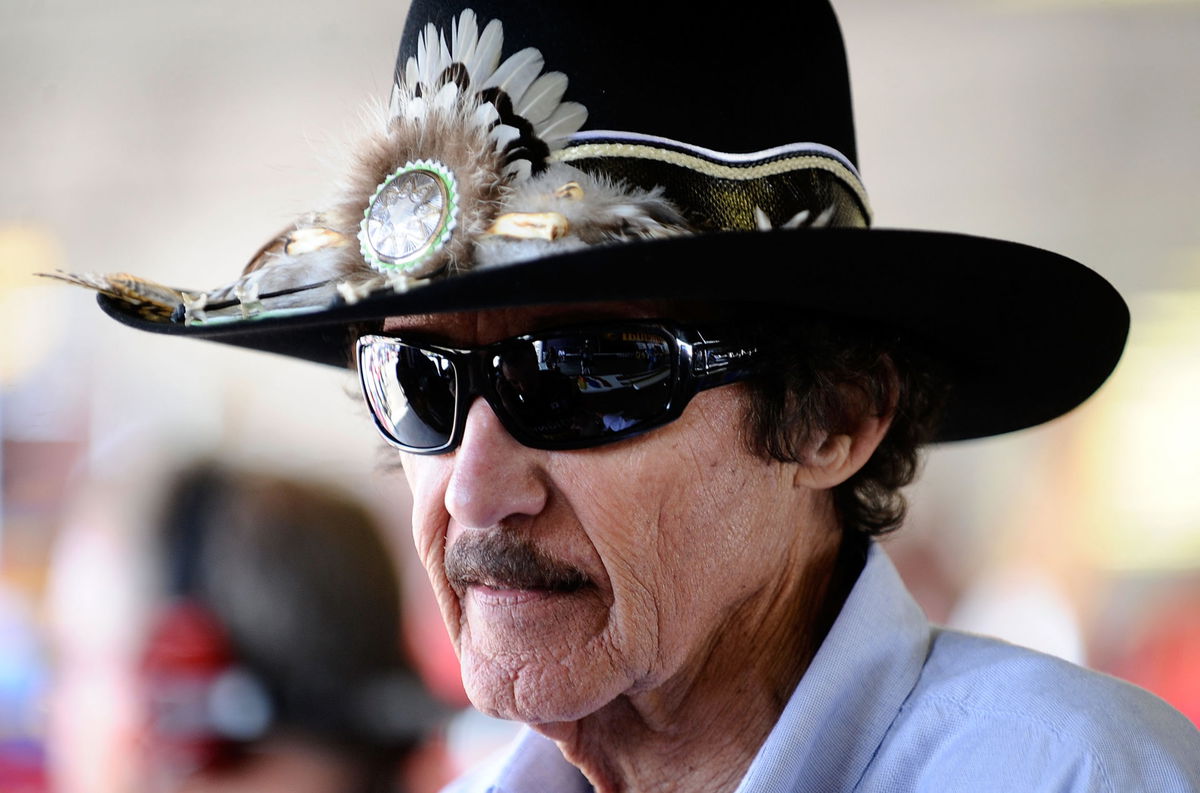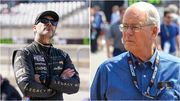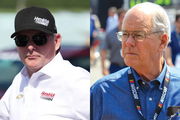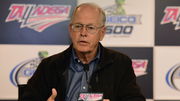
Getty
WATKINS GLEN, NY – AUGUST 06: Team owner Richard Petty stands in the garage during practice for the NASCAR Heluva Good! Sour Cream Dips at The Glen on August 6, 2010 in Watkins Glen, New York. (Photo by Jeff Zelevansky/Getty Images for NASCAR)

Getty
WATKINS GLEN, NY – AUGUST 06: Team owner Richard Petty stands in the garage during practice for the NASCAR Heluva Good! Sour Cream Dips at The Glen on August 6, 2010 in Watkins Glen, New York. (Photo by Jeff Zelevansky/Getty Images for NASCAR)
Richard Petty knows a thing or two about navigating his way on a racetrack with dirty air. During NASCRA’s iconic muscle car era, he built his legend behind the wheel of aerodynamically advanced machines like Plymouth’s 1970 Superbird, complete with its towering spoiler and wind-cheating bodywork that heralded the outlaw aero cars of the early ’70s. Petty’s embrace of wind-tunnel-informed design revolutionized NASCAR, combining raw horsepower with airflow mastery to dominate. And it’s this legacy of aerodynamic innovation that still informs how legends race today. King Petty bagged 18 wins with the iconic car, but NASCAR’s rule change for equalizing the field ended this experiment by 1971.
Watch What’s Trending Now!
Fast-forward to this past weekend at Pocono Raceway, and the notorious ‘Tricky Triangle’ lived up to its name once again. The 2.5-mile tri-oval, famed for its three distinct turns, tested drivers with high-speed straights and aero-demanding corners where slipstreams and turbulent air can make or break a day. The aerodynamic feature was back with the Next Gen car, but for Richard Petty, the aero-heavy race car deciding the win for Chase Briscoe didn’t sit well. He was highlighting the core issue of the new car with the aero-sensitive body design, which aids the race leader.
ADVERTISEMENT
Richard Petty shares aero wisdom after turbulent Pocono weekend
In a recent snippet shared on Instagram from Petty Family Racing’s YouTube Channel of the latest episode of Petty Race Recap, yet to be released, Richard Petty was seen sharing his opinions over the race, which was decided by air, and his views about the track. “They’d run up there and get right behind him and the air would pick them up and first thing you know they’re 100 yards behind,” said Petty. While he didn’t use the old “wing” jargon, Petty praised drivers who kept their cars relaxed and sliding in turbulent zones, asserting that a smart aero strategy was the key to winning at Pocono, citing the example of the winner, Chase Briscoe.
While the other cars that were trailing behind Briscoe were more prone to dirty air being thrown at them, Richard Petty‘s insight was more than theoretical, it remains a sharp critique of Next Gen cars which are maximally sensitive to clean air, racing in tight packs, but one misstep could drop a contender way back on the track. “They’d work their way back and back and back and get pretty close and then bam they’re gone again,” continued Petty.
“One on one there was no passing at all. Of all the races we’ve run so far I think the air showed up the most at Pocono than it has any place we’ve run because everybody got caught up in it,” he said. the are saw Chase Briscoe barely escaping the drone of turbulence, but virtually no one could pass cleanly as drivers were repeatedly changing positions and sliding back, unable to close the gap before getting blown away again. Hamlin tried his best, but he couldn’t gain any ground on the #19 Toyota Camry despite the car running low on fuel.
ADVERTISEMENT
View this post on Instagram
Even Denny Hamlin, in his podcast ‘Actions Detrimental,’ agreed that the aerodynamic advantage for some Next Gen cars, including Briscoe’s, made it hard for him to pass the leader. “This car, obviously, he’s (Briscoe) got tremendous aerodynamic advantage, where he’s got all the air coming down on his car, pushing it down the racetrack,” said Hamlin. “When I drive in, at the time, I think he was kind of running in the middle lane, I was running the bottom, getting a run, he comes down, soon as he puts me in his full wake, and my car just takes off.”
ADVERTISEMENT
Petty highlighted that despite being hunted down, Briscoe put on a masterclass defense, thanks to aero aero-heavy feature of the car. “So what the 19 was doing, he was relaxed and he let the car be relaxed and it was making better time than it was if he was in there digging around.” Heck, even Ryan Blaney wasn’t able to surge past Hamlin on the final few laps, where Chris Buescher couldn’t keep up the pace after he was mired in traffic.
On the flip side, Petty also talked about NASCAR’s grand business schemes and expansion plan. And going by his words, he doesn’t seem to be sold on the idea that the leadership at NASCAR is proposing.
Top Stories
Jimmie Johnson & Co. Robbed of Millions as Court Exposes Disastrous Fallout of Jim France’s ‘No Bueno’ Decision

Jeff Gordon Duped Into False Hope as NASCAR’s Blatant Lie Exposes Jim France as Culprit No. 1

Displeased Judge Bell Explodes on NASCAR Lawyers Caught Red-Handed In Dirty Courtroom Tactics

Why Did Chris Gabehart Leave Denny Hamlin & JGR? What His Exit Means to Joe Gibbs & Spire Motorsports?

NASCAR Trapped in $61M Financial Nightmare as Steve O’Donnell Admits Stripping Team Power to Force Mexico Agenda

ADVERTISEMENT
Petty pushes back as NASACR eyes San Diego street race
Following Shane van Gisbergen’s dominant victory at Mexico City last week, NASCAR appears ready to double down on its international and street racing efforts. Reports suggest the series is nearing a deal for a street course event in San Diego, California, its first points-paying race in the region since California Speedway shut down in 2023. The potential race could land as early as 2026, filling the void in Southern California’s racing calendar, with hints that a final agreement could come within the month. Meanwhile, the Mexico Race was met with roaring enthusiasm, from packed grandstands to eager fan interactions.
Yet not everyone is onboard with the direction NASCAR seems to be heading. Richard Petty openly criticized the increasing focus on street and road courses, expressing concern about their impact on the integrity of stock car racing. Petty, tied for the most Cup Series championships in history, pointed to van Gisbergen’s win and subsequent playoff berth while ranked just 30th in points, as an example of the system’s flaws.
“From the standpoint that you got somebody, like I say, that’s 30th in the points that’s going to make the playoffs, hey man, what happened to the guy that’s 15th or 16th or 18th?” said Petty. “You know, been running good, finished good everywhere. You’re making a championship situation by winning a road course, which is not really a NASCAR to begin with. So from that standpoint, I think they’re going to have to jockey around and change some of this kind of stuff.”
ADVERTISEMENT
While the format has historically led to unpredictable playoff storylines, SVG’s 16+ second margin of victory only intensified the debate. His dominance not only locked in a postseason slot but also reignited discussion about the weight road courses should carry in NASCAR’s championship structure. NASCAR, however, is standing firm on its long-term growth strategy, as Ben Kennedy said, “I would say for us, this is more of a strategic move as a sport to expand our footprint globally and internationally and to a new mass fan base. Just being in a country with 90 million people and over 20 million people in the larger Mexico City metro alone, not in and of itself, this is a success.”
With eyes now set on San Diego and a potential 2026 return to Mexico City for a points race, NASCAR continues balancing tradition with expansion.
ADVERTISEMENT
ADVERTISEMENT
ADVERTISEMENT
ADVERTISEMENT

